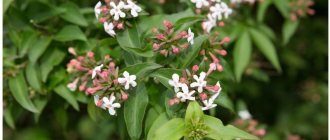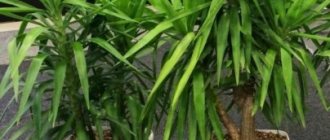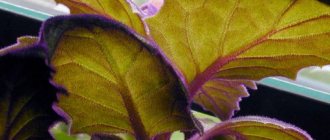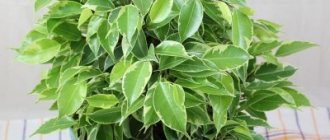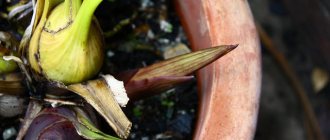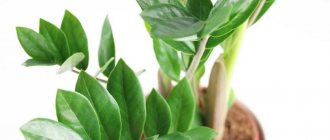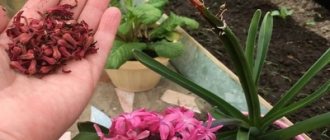general information
Surely every gardener has a rough idea of what a tea tree looks like.
This is a large, beautiful evergreen plant that grows into a small spreading tree with age. Some Melaleuca species have very short petioles, while others have none at all.
Tea tree
The ovoid-shaped leaves are located one on each side. Fragrant flowers are united in loose cylindrical or spherical inflorescences. The flowers consist of a 5-tufted bouquet of stamens. The petals fall off at the very beginning of flowering. Subsequently, the flowers give way to strong, closed capsules with seeds, which lean very tightly against the branches.
The tree has a rather unusual light-colored flaky bark.
Interesting! In some species, the bark tends to peel off from the plant in thin but fairly wide layers. For this reason, Melaleuca received the name paperbark tree.
Another important feature of tea tree is its medicinal properties. The plant is rich in essential oils that actively fight germs, viruses and fungi.
For reference! Official medicine recognized the healing properties of melaleuca back in the first half of the 20th century.
General information
Due to the special arrangement of leaves, it is classified as an alternate-leaved species. The name from Greek is translated as a combination of black and white, and was given to the tree for the unusual combination of colors of the bark and trunk.
Melaleuca is called the Australian tea tree, which, although similar in appearance to the New Zealand tea tree (manuka), is actually completely different in its properties.
Although they have similar foliage to each other, they have, for example, different flowers. Therefore, since the plant is used for medicinal purposes, you should carefully monitor which tree you are talking about.
- The tree has light brown bark that peels off in thin and relatively large parts, for which it is also called paperbark. When the bark peels away from the trunk, it appears through it in white spots.
- The leaves are oval or ellipsoidal, light green in color, pointed towards the upper edge, grow on the shoots oppositely and often, somewhat reminiscent of pine needles.
- The petioles are short, sometimes completely absent.
- The foliage smells strongly of camphor due to the abundance of healing essential oil in it.
Previously, we talked about growing a myrtle tree at home.
Bloom
Tea tree Melaleuca alternate leaf begins to bloom in the spring. The flowers have many white needle-like petals, which fall off almost at the beginning of the flowering period and only bunches of stamens of red, white, and lilac flowers remain.
The flowers are located in loose inflorescences of a spherical or cylindrical paniculate shape. They have a strong aroma and are an excellent honey plant.
When the flowering period ends, seed pods are formed, pressed against the branches.
The healing effect of the essential oils of these plants has long been used for medicinal purposes. Back in the 18th century, this plant was brought to Europe from Australia and is still used as an antiseptic that destroys fungi and microbes.
Types of Melaleuca
The tree is used for decorative purposes in urban landscaping in East Asia. In our country, it is mainly grown at home as a houseplant. The following types of melaleuca are suitable for this.
- Melaleuca alternate-leaved is a small tree with long, up to three and a half centimeters, narrow, about one millimeter, green leaves that can be confused with spruce needles. Its abundant flowering begins in spring and continues until early summer, inflorescences up to five centimeters in size, cylindrical in shape. Development is slow.
- Melaleuca flaxseed is a small, but fast-growing evergreen tree. The foliage color is green with a gray tint, the structure is dense, leathery. Their length reaches up to four and a half centimeters, their width exceeds all other types and is four millimeters. It blooms in summer, the flowers are airy, resembling fluff, concentrated in four centimeter inflorescences of white paniculate shape, covering the tree very tightly. The dwarf form of this species is very popular among gardeners.
- Melaleuca diosmofolia is a shrub with small, up to one centimeter, green, oval-shaped leaves, arranged in a spiral and very densely. It blooms from spring to early autumn, the flowers are yellow-green, the inflorescences are up to five centimeters in size, cylindrical in shape, a very good honey plant.
- Melaleuca nesophila is a shrub that reaches a fairly significant size when developing. Two centimeter green leaves with a gray tint. The flowers are purple, concentrated in spherical inflorescences three centimeters in diameter. Flowering from spring to mid-summer. Excellent honey plant.
- Melaleuca is beautiful - a low shrub creeping along the surface of the ground. The leaves are dark green, oval, up to six millimeters long, similar to fir needles. The flowers are pink, concentrated in rare inflorescences. The shape of the flowers resembles a paw with claws due to the combination of stamens and cup-shaped petals.
Melaleuca: home care
For home floriculture, it is recommended to choose the smallest types of tea tree, since they are much easier to grow and easier to care for. For example, these include the alternate-leaved melaleuca, the smallest member of the family that can be used to form bonsai.
Indoor mint: home care and methods of propagation
The tree has elongated and narrow leaves similar to conifer needles. According to reviews from flower growers, melaleuca of this species is an unpretentious plant, but for regular and abundant flowering it needs to be properly cared for.
- Watering
In the wild, melaleuca grows on river banks and in swampy areas. Therefore, it requires systematic, abundant watering. If the soil dries out completely, the plant may die. However, stagnant water can also harm the tree, as it causes rotting of the roots.
Melaleuca should be watered with soft, settled water. To soften hard tap water, add acetic or citric acid (in small quantities).
If the winter turns out to be quite cool, then the intensity of watering should be reduced slightly. Watering should be done after the top layer of the substrate has dried slightly.
- The soil
A neutral or slightly acidic well-drained soil substrate is suitable for growing tea tree.
To make an earthen mixture, you need to mix peat (2 parts) with turf soil (1 part) and sand (1 part).
Important! If the soil is being prepared for beautiful melaleuca, then more sand should be added to the substrate.
- Fertilizers
The tea tree needs periodic feeding. From mid-spring to mid-autumn it is necessary to fertilize once every two weeks.
For this purpose, mineral fertilizers are used, which are mixed with irrigation water in the proportion specified in the instructions.
- Humidity
In order to grow melaleuca, high air humidity is required. In winter, containers with plants should not be left near radiators.
The tree needs frequent spraying.
In addition, you should use pallets with wet expanded clay or pebbles.
Home care
Kinds
There are about 240 species in total, which are divided into numerous varieties:
- Cayuput tree – Melaleuca leucadendra. Tree up to 25 m tall, the trunk is covered with very light, almost white, bark. Near the ground it is almost black. Hence the name melaleuca (black and white). The leaf blades are narrow, elongated, and have a pleasant green hue. The inflorescences are white, reminiscent of a household brush.
- Melaleuca alternifolia. It is the most valuable representative of melaleuca, as it contains the same essential oil used in various fields. It contains more than 50 useful substances. It grows relatively low - up to 8 m. The foliage is bright green, the flowers are snow-white. The thin bark often peels off and flakes off in large pieces that look very papery.
- Melaleuca quinquenervia. At home and in some other countries it is used to drain wetlands and to decorate streets and parks. It got its name because of the structure of the oval leaf blade, consisting of 5 veins. Can grow from 9 to 19 m in height. The flowers are collected in cylindrical brushes, painted in light colors - white, beige.
Trimming
The indoor tea tree needs systematic annual pruning. The shape of the plant after the procedure can be absolutely any, since it largely depends on the wishes of the grower himself.
Bouvardia flower: home care and methods of propagation
The tree is very flexible to shape changes, so it can be shaped both as a bush and as a tree. In addition, pruning allows you to get rid of faded branches, which often spoil the appearance of the plant.
Young trees do not need pruning. For better branching of the bushes, they should be cut at a height of 10 centimeters.
Note! As the tree grows, each new stem should be trimmed until the desired degree of branching is established.
There are only 5 types of tea tree pruning. They differ in that as a result of using each of them the plant will look different.
Trimming types:
- modeling;
- light;
- deep;
- heavy;
- under the root.
Modeling pruning is used to accelerate the growth of buds in young plants, improve and organize branching, develop the “skeleton” of the tree, as well as strengthen lateral branches and form layers. Side branches strengthen the tea bush, increase the bearing surface of the bush and help it survive low temperatures during frosty periods, which has a positive effect on yield.
Light pruning helps increase the number of buds. This type of pruning is used for plants intended for the cultivation of this raw material - tender buds. It is worth noting that after a certain number of procedures the buds become coarser, and at the same time the nutritional strength of the plant is significantly reduced. During this period, deep pruning will be most appropriate. To do this, 10-15 cm of branches along with foliage are cut from the bushes. This allows the tea tree to cope with stress more easily and also helps restore strength.
Tea tree pruning
Heavy pruning and root pruning are intended to rejuvenate the plant. Some tree species, when they reach a certain size, begin to show signs of aging. In this case, light pruning methods do not help, so heavy pruning is used.
About 30 cm is cut from the plants, and if the tree is quite tall, then you can trim up to half its height. In case of a serious disease, the bush is cut off at the root, leaving no more than 10 cm above the ground. This type of pruning is sometimes used before replanting the plant.
Diseases, pests and problems in growing
Tea is considered a pest and disease resistant houseplant; even in bonsai form it rarely gets sick. But still, problems in its development cannot be avoided. The plant reacts very sensitively to changing conditions, often loses its decorative effect, and may look stunted for no obvious reason. You need to carefully monitor the tea, constantly check the condition of the substrate and leaves, and adjust care at the first signs of wilting.
Often the loss of decorativeness of leaves is associated with flowering: in some home tea bushes, the leaves quickly lose their decorativeness when they ripen and the buds begin to bloom. The plant will recover over time, after flowering has ended, but for bonsai and mature trees it is sometimes better to prevent flowering, focusing on the main goal - preserving the beauty of the bushes.
Features of transplantation
Young tea trees develop quite quickly, so they need to be replanted annually. For adult plants, the norm is one transplant every 2-3 years.
Catharanthus flower: home care and methods of propagation
With each subsequent procedure, you need to select a new pot that is larger in volume than the previous one. If the melaleuca grows too much, you need to partially trim the root system, followed by replanting it in a new container.
Important! Sufficient drainage must be used when replanting.
The soil mixture should include peat (2 parts), sand (1 part) and turf soil - an earthen layer of small fallen twigs, dry leaves and grass residues (1 part).
Tea tree transplant
How to water a flower
Regular but moderate watering is one of the basic rules of home care. A living tree is a succulent, which means it can withstand drought more easily than waterlogging. But complete drying out of the soil can be detrimental to Crassula. Therefore, be responsible when watering.
In summer, when the weather is hot, moisten the soil every 3-4 days. In winter, reduce watering to a minimum. If you keep the plant in a warm apartment, then 1-2 waterings per month will be enough. How do you know exactly when it’s time to moisten the soil? Check it, and if the substrate has dried to a depth of 3-4 cm, then water the flower.
At any time of the year, for hydration, use exclusively rain or melt water, the temperature of which is 2-3 degrees higher than in the room. In extreme cases, tap water will do. But before watering, it needs to be filtered and left for 3-4 days.
Crassula easily tolerates the dry air of apartments; it does not need spraying. But still, the leaves of the crop need to be regularly wiped with a damp cloth to remove dust. Otherwise, the dirt will block the access to fresh air, which will have a bad effect on the health and decorativeness of the tree.
And it is also sometimes useful for the plant to take a warm shower. But during this procedure, make sure that moisture does not get into the soil. Therefore, be sure to wrap the pot in plastic. To prevent the tree from getting too cold, return it to its usual place after a shower only when all the liquid has drained.
Reproduction methods
There are two ways to propagate melaleuca in a pot: seeds or cuttings.
Seeds
In order to propagate a tea tree by seeds, you need to do the following:
- Take boiled water into a container and soak the seeds in it. The duration of soaking is three days. The water needs to be changed daily.
- Discard the floating seed. Deepen the remaining seeds into a thin layer of slightly acidic soil. Cover the top with film or glass.
- Organize daily half-hour ventilation.
- When watering, make sure that the soil does not dry out or become sour.
- After 2-6 weeks, the first shoots should appear.
Cuttings
In the case of propagation by cuttings, the algorithm of actions is as follows:
- Select a number of lignified shoots up to 8 cm in length.
- Plant the cuttings in vermiculite (moist) and place them in a well-lit place.
- Cuttings can be fed with phytohormones. They significantly accelerate growth.
- Water regularly and avoid too little or too much moisture.
Tip 1: When to water indoor plants
My grandmother also told me how to water flowers correctly. In winter and autumn, plants need to be watered in the morning. In summer and spring - in the evening.
This is due to the fact that when watering, the temperature of the earthen coma decreases significantly. In turn, cooling the soil leads to a decrease in the activity of the root system, resulting in a decrease in the ability to absorb water.
Thus, in the hotter seasons, flowers do not have enough moisture for transpiration, so they are watered after the general air temperature has dropped. In the winter-autumn period, watering is carried out in the morning, which allows the temperature of the earthen coma to rise during the day and avoid hypothermia at night.
Medicinal properties
Tea tree essential oil is an excellent antiseptic, strong anti-inflammatory and antiviral agent. It has a number of useful properties, here are some of them:
- Relieves depression and stress. Melaleuca oil activates the brain, helps strengthen memory and improves perception of reality.
- Antibacterial, antiviral and antifungal properties. The oil can act as an alternative to a number of cold and flu medications. It contains compounds that fight bacteria, viruses and fungi.
- Anti-inflammatory and regenerating effect. Tea tree oil reduces inflammation and stimulates the work of white blood cells, which play a significant role in the healing process.
- Antifungal properties. The oil contains compounds that fight the growth and spread of mold on vegetables and fruits.
- Antioxidant properties. Tea tree essential oil, among other things, also has antioxidant properties.
Medicinal properties of malekuka
Note! In case of individual intolerance, essential oil should not be used.
Despite the fact that the tea tree is still a rather rare phenomenon that can rarely be seen at home, one can still note a trend towards its popularization. More and more often there are gardeners who, in search of something exotic, choose this particular plant. However, few of them, even after planting it in a pot, realize the value of this treasure.
Benefits of tea tree
Essential oil contains many chemical compounds and biologically active substances that have a beneficial effect on the human body.
Medicinal properties:
- - bactericidal;
- - antifungal;
- - antiviral;
- - general strengthening;
- - preventive.
Melaleuca oil is great for healing treatments
Aromatherapy
The tart, slightly bitter, refined aroma of the oil stimulates the nervous system and harmonizes mental energy. It is considered a source of intellectual ease, helps to quickly remember information, supports mental activity, and promotes concentration.
Massotherapy
Tea tree oil has a warming effect and provides excellent gliding without causing irritation or dryness of the skin.
Treatment of wounds, abrasions, bites
Quickly relieves pain and inflammation in skin lesions. Relieves swelling, eliminates itching, redness after insect bites.
Inhalations for colds
For prolonged coughs, it is useful to inhale with healing oil. To do this, boil water, cool slightly, add one or two drops of essential oil and breathe over the pan for five minutes, covered with a towel.
When inhaling medicinal vapors, close your eyes so as not to cause burning and tearing.
In cosmetology
Essential oil is used to strengthen hair, give it a healthy look and get rid of dandruff. This is an excellent product for preparing cleansing masks for oily and problematic skin. It is also successfully used to treat acne, herpes, and remove warts.
Important: Tea tree essential oil can be dangerous if used incorrectly. When using the oil externally, avoid areas around the eyes and mouth and do not apply it to the nose, ears or deep wounds.
When taken orally in case of overdose, tea tree oil can cause weakness, stomach upset and other effects.
Use tea tree oil according to the instructions, in the correct concentration and after consulting your doctor!
Tea tree oil in dentistry
The resulting oil from melaleuca leaves is used in dentistry. This is an excellent antiseptic that helps normalize microflora in the oral cavity. Recently, dental clinics have been practicing teeth whitening using natural essential oils.
Let us remind you that the whitening procedure can be carried out only after making sure that you do not have caries or other diseases of the oral system that require immediate intervention from a specialist.
Having visited the dental clinic, you will be satisfied with the coziness, comfort and attentiveness of the staff. The use of modern equipment will eliminate discomfort and pain during treatment.
Thanks to the soft and delicate action of the oil, tooth enamel is not damaged during the procedure. Therefore, this method is considered safer than using abrasive toothpastes or soda.
It is worth noting that you will not find obvious and quick whitening results in the first days of use. But if you want to choose a truly harmless home whitening product, then choose this product.
Additional benefits of the procedure
:
- gum diseases are cured, bleeding disappears within a short time;
- eliminates bad breath, the oil has a detrimental effect on bacteria and fungi that cause halitosis;
— tartar is destroyed, hard deposits transformed into stone are gradually eliminated and the teeth shine with cleanliness.
A significant advantage of treatment with this remedy is that one bottle of tea tree oil will last you a long time, and the result will be amazing. Just before you start restoring your health, consult a specialist to find out if you have any allergic reactions to the drug. The doctor at the dental clinic will conduct a professional examination, advise and recommend the correct treatment.
Care, professionalism, individual approach and friendliness are the main qualities of Studio 32 employees. Once you become a patient of the clinic, you can be sure that from now on your smile will shine with impeccable beauty.
PHOTO OF TEA TREE
How to grow lilacs on a windowsill
On cold winter evenings I really want to have a piece of spring at home. Lilac just symbolizes her arrival. If you wish, you can get a blooming sprig of lilac for the New Year holiday, but you will have to try for this.
To do this, in September-October, lilac shoots about 80 cm long are cut and packed in polyethylene, placed in the refrigerator, and kept in the refrigerator for 4-5 weeks.
Important! The temperature should be -2-5 degrees. After this, the shoots are dipped in a container of cold water for 10-12 hours.
All that remains is to place the shoots in a container with clean water in an upright position. Maintain the optimal temperature in the room:
After this, the shoots are dipped in a container with cold water for 10-12 hours. All that remains is to place the shoots in a container with clean water in an upright position. Maintain the optimal temperature in the room:
- 1 week – 25 degrees;
- Week 2 – 20 degrees;
- subsequent weeks – 18-20 degrees.
If all conditions are met, you can get blooming lilacs on the windowsill in 3-4 weeks.
